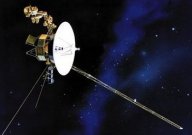Space & Astronomy
March 21, 2013 · 38 comments
38 comments

Image Credit: NASA
Back in August a large increase in cosmic rays coupled with a drop in the intensity of energetic particles coming from the Sun signaled Voyager's potential exit from the heliosphere region at the very edge of the solar system. "Within just a few days, the heliospheric intensity of trapped radiation decreased, and the cosmic ray intensity went up as you would expect if it exited the heliosphere," said Prof Bill Webber. Some of the scientists at NASA however aren't convinced that this is definitive evidence that the probe has entered interstellar space.
Once it does leave the solar system the spacecraft will have a long, cold journey ahead of it. On it's current course and speed Voyager-1 will take somewhere in the region of 40,000 years to travel anywhere close to the next nearest star.[!gad]Voyager-1 was launched back in 1977, embarking on a pioneering mission to explore the outer planets for the first time. It didn't stop there however, the spacecraft has been traveling now for more than 35 years and is located a staggering 18 billion kilometers away, the equivalent of 123 times the distance between the Earth and the Sun. Many scientists believe that Voyager has now left the solar system entirely, yet there is still much debate on the topic of exactly where our solar system ends and interstellar space begins.
Back in August a large increase in cosmic rays coupled with a drop in the intensity of energetic particles coming from the Sun signaled Voyager's potential exit from the heliosphere region at the very edge of the solar system. "Within just a few days, the heliospheric intensity of trapped radiation decreased, and the cosmic ray intensity went up as you would expect if it exited the heliosphere," said Prof Bill Webber. Some of the scientists at NASA however aren't convinced that this is definitive evidence that the probe has entered interstellar space.
Once it does leave the solar system the spacecraft will have a long, cold journey ahead of it. On it's current course and speed Voyager-1 will take somewhere in the region of 40,000 years to travel anywhere close to the next nearest star.
Source: BBC News | Comments (38)
Has Voyager left the solar system ?
By T.K. RandallMarch 21, 2013 ·
 38 comments
38 comments
Image Credit: NASA
The debate is on over whether or not the Voyager spacecraft has finally entered interstellar space.
Voyager-1 was launched back in 1977, embarking on a pioneering mission to explore the outer planets for the first time. It didn't stop there however, the spacecraft has been traveling now for more than 35 years and is located a staggering 18 billion kilometers away, the equivalent of 123 times the distance between the Earth and the Sun. Many scientists believe that Voyager has now left the solar system entirely, yet there is still much debate on the topic of exactly where our solar system ends and interstellar space begins.Back in August a large increase in cosmic rays coupled with a drop in the intensity of energetic particles coming from the Sun signaled Voyager's potential exit from the heliosphere region at the very edge of the solar system. "Within just a few days, the heliospheric intensity of trapped radiation decreased, and the cosmic ray intensity went up as you would expect if it exited the heliosphere," said Prof Bill Webber. Some of the scientists at NASA however aren't convinced that this is definitive evidence that the probe has entered interstellar space.
Once it does leave the solar system the spacecraft will have a long, cold journey ahead of it. On it's current course and speed Voyager-1 will take somewhere in the region of 40,000 years to travel anywhere close to the next nearest star.[!gad]Voyager-1 was launched back in 1977, embarking on a pioneering mission to explore the outer planets for the first time. It didn't stop there however, the spacecraft has been traveling now for more than 35 years and is located a staggering 18 billion kilometers away, the equivalent of 123 times the distance between the Earth and the Sun. Many scientists believe that Voyager has now left the solar system entirely, yet there is still much debate on the topic of exactly where our solar system ends and interstellar space begins.
Back in August a large increase in cosmic rays coupled with a drop in the intensity of energetic particles coming from the Sun signaled Voyager's potential exit from the heliosphere region at the very edge of the solar system. "Within just a few days, the heliospheric intensity of trapped radiation decreased, and the cosmic ray intensity went up as you would expect if it exited the heliosphere," said Prof Bill Webber. Some of the scientists at NASA however aren't convinced that this is definitive evidence that the probe has entered interstellar space.
Once it does leave the solar system the spacecraft will have a long, cold journey ahead of it. On it's current course and speed Voyager-1 will take somewhere in the region of 40,000 years to travel anywhere close to the next nearest star.
The possibility that the Voyager-1 spacecraft may have left the Solar System is being hotly debated. Launched in September 1977, the probe was sent initially to study the outer planets, but then just kept on going.
Source: BBC News | Comments (38)

The Unexplained Mysteries
Book of Weird News
AVAILABLE NOW
Take a walk on the weird side with this compilation of some of the weirdest stories ever to grace the pages of a newspaper.
Click here to learn more

Support us on Patreon
BONUS CONTENTFor less than the cost of a cup of coffee, you can gain access to a wide range of exclusive perks including our popular 'Lost Ghost Stories' series.
Click here to learn more
Ancient Mysteries and Alternative History
Palaeontology, Archaeology and History
Natural World
Philosophy and Psychology
Total Posts: 7,776,489 Topics: 325,448 Members: 203,878
Not a member yet ? Click here to join - registration is free and only takes a moment!
Not a member yet ? Click here to join - registration is free and only takes a moment!



























Please Login or Register to post a comment.